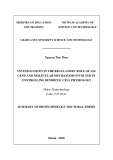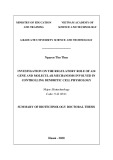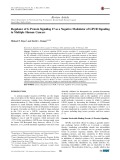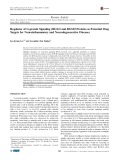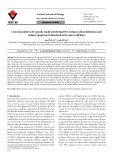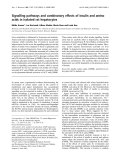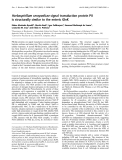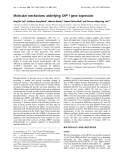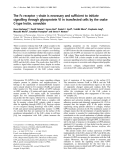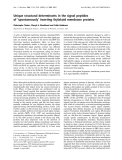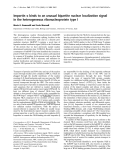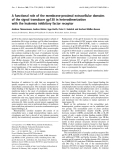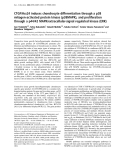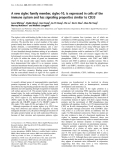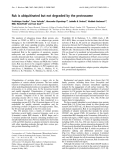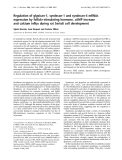
Cell signaling
-
The objectives of the thesis: Investigate the role of A20 in regulating four physiological functions of DCs including maturation, cytokine secretion, migration and apoptosis. Investigate the effect of A20 on the regulating three molecular signals including NF-κB, STAT1 and STAT3 related to the physiological process of DCs.
 27p
27p  extraenglish
extraenglish
 24-05-2021
24-05-2021
 17
17
 4
4
 Download
Download
-
The objectives of the thesis: Investigate the role of A20 in regulating four physiological functions of DCs including maturation, cytokine secretion, migration and apoptosis; investigate the effect of A20 on the regulating three molecular signals including NF-κB, STAT1 and STAT3 related to the physiological process of DCs.
 27p
27p  capheviahe27
capheviahe27
 23-02-2021
23-02-2021
 19
19
 4
4
 Download
Download
-
Regulators of G protein signaling (RGS) proteins modulate G protein-coupled receptor (GPCR) signaling networks by terminating signals produced by active Gα subunits. RGS17, a member of the RZ subfamily of RGS proteins, is typically only expressed in appreciable amounts in the human central nervous system, but previous works have shown that RGS17 expression is selectively upregulated in a number of malignancies, including lung, breast, prostate, and hepatocellular carcinoma.
 10p
10p  caothientrangnguyen
caothientrangnguyen
 09-05-2020
09-05-2020
 14
14
 1
1
 Download
Download
-
Regulator of G-protein signaling (RGS) proteins were originally identified as negative regulators of G-protein-coupled receptor (GPCR) signaling via their GTPase-accelerating protein (GAP) activity. All RGS proteins contain evolutionarily conserved RGS domain; however, they differ in their size and regulatory domains. RGS1 and RGS10 are smaller than other RGS proteins, and their functions involve various inflammatory responses including autoimmune responses in both the periphery and the central nervous system (CNS). Neuroinflammation is the chronic inflammatory response in the CNS.
 5p
5p  caothientrangnguyen
caothientrangnguyen
 09-05-2020
09-05-2020
 31
31
 2
2
 Download
Download
-
The signaling properties of the gasotransmitter molecule hydrogen sulfide (H2S), which is endogenously generated in plant cells, are mainly observed during persulfidation, a protein post-translational modification (PTM) that affects redox-sensitive cysteine residues. There is growing experimental evidence that H2S in higher plants may function as a mechanism of response to environmental stress conditions.
 7p
7p  partimesinhvien
partimesinhvien
 08-05-2020
08-05-2020
 36
36
 1
1
 Download
Download
-
Head and neck squamous cell carcinoma (HNSCC) is the most common and most aggressive type of head and neck cancer. Current approaches for the treatment of HNSCC are not sufficient to increase the patient survival or to reduce the high recurrence rate.
 12p
12p  nutifooddau
nutifooddau
 27-01-2019
27-01-2019
 28
28
 3
3
 Download
Download
-
Liver metabolism is influenced by hormones and nutrients. Amino acids such as glutamine or leucine induce an anabolic response, which resembles that of insulin in muscle and adipose tissue. In this work, the signalling pathways and the effects of insulin were compared to those of glutamine and leucine in isolated hepatocytes from normal and streptozotocin-diabetic rats.
 9p
9p  system191
system191
 01-06-2013
01-06-2013
 50
50
 5
5
 Download
Download
-
PII-like proteins are signal transduction proteins found in bacteria, archaea and eukaryotes. They mediate a variety of cellular responses. A second PII-like protein, called GlnK, has been found in several organisms. In the diazotroph Herbaspirillum seropedicae, PII protein is involved in sensing nitrogen levels and controlling nitrogen fixation genes. In this work, the crystal structure of the unliganded H. seropedicae PII was solved by X-ray diffraction. H. seropedicae PII has a Gly residue, Gly108 preceding Pro109 and the main-chain forms a b turn. ...
 8p
8p  system191
system191
 01-06-2013
01-06-2013
 39
39
 5
5
 Download
Download
-
This study addresses the interactions between the adaptor protein Shb and components involved in T cell signalling, including SLP-76, Gads, Vav and ZAP70. We show that both SLP-76 and ZAP70 co-immunoprecipitate with Shb in Jurkat T cells and that Shb and Vav co-immunoprecipitate when cotransfected in COS cells. We also demonstrate, utilizing fusion protein constructs, that SLP-76, Gads and Vav associate independently of each other to different domains or regions, of Shb.
 10p
10p  system191
system191
 01-06-2013
01-06-2013
 37
37
 5
5
 Download
Download
-
SHP-1, a protein-tyrosine phosphatase with two srchomology 2 domains, is expressed predominantly in hematopoietic and epithelial cells and has been implicated in numerous signaling pathways as a negative regulator. Two promoters direct the expression of human and murine SHP-1, and two types of transcripts (I) and (II) SHP-1, are initiated from each of these promoters. The cDNA sequences of (I)SHP-1 and (II)SHP-1 are identical except in the 5¢ untranslated region and in the first few coding nucleotides.
 8p
8p  system191
system191
 01-06-2013
01-06-2013
 41
41
 3
3
 Download
Download
-
There is extensive evidence that FcR c-chain couples to the collagen receptor glycoprotein VI (GPVI) and becomes phosphorylated on tyrosines upon receptor cross-linking. However, it is not established whether this receptor complex is sufficient to initiate the signalling cascade. We transfected GPVI and the FcR c-chain into the human erythroleukaemia cell line K562, which lacks detectable expression of GPVI and the FcR c-chain. The results show that GPVI is unable to signal when expressed alone, despite its surface expression, upon stimulation with the snake C-type lectin, convulxin....
 10p
10p  system191
system191
 01-06-2013
01-06-2013
 37
37
 3
3
 Download
Download
-
The present work reports isolation and characterization of a highly glycosylated protein from bovine milk fat globule membranes, known as PAS III. Partial amino-acid sequencing of the purified protein allowed construction of degenerate oligonucleotide primers, enabling isolation of a full-length cDNA encoding a protein of 330 amino-acid residues. N-terminal amino-acid sequencing of derived peptides and the purified protein confirmed 76% of the sequence and demonstrated presence of a cleavable signal peptide of 23 residues, leaving a mature protein of 307 amino acids.
 9p
9p  system191
system191
 01-06-2013
01-06-2013
 51
51
 4
4
 Download
Download
-
A series of thylakoid membrane proteins, including PsbX, PsbY and PsbW, are synthesized with cleavable signal peptides yet inserted using none of the known Sec/SRP/Tat/ Oxa1-type insertion machineries. Here, we show that, although superficially similar to Sec-type signal peptides, these thylakoidal signal peptides contain very different determinants.
 11p
11p  system191
system191
 01-06-2013
01-06-2013
 48
48
 4
4
 Download
Download
-
The heterogeneous nuclear ribonucleoprotein (hnRNP) type I, a modulator of alternative splicing, localizes in the nucleoplasm of mammalian cells and in a discrete perinucleolar structure. HnRNP I contains a novel type of bipartite nuclear localization signal (NLS) at the N-terminus of the protein that we have previously named nuclear determinant localization type I (NLD-I). Recently, a neural counterpart of hnRNP I has been identified that contains a putative NLS with two strings of basic amino acids separated by a spacer of 30 residues....
 8p
8p  system191
system191
 01-06-2013
01-06-2013
 26
26
 3
3
 Download
Download
-
gp130 is the common signal transducing receptor subunit of interleukin (IL)-6-type cytokines. gp130 either homodimerizes in response to IL-6 and IL-11 or forms heterodimers with the leukemia inhibitory factor (LIF) receptor (LIFR) in response to LIF, oncostatin M (OSM), ciliary neurotrophic factor (CNTF), cardiotrophin-1 (CT-1) or cardiotrophinlike cytokine resulting in the onset of cytoplasmic tyrosine phosphorylation cascades. The extracellular parts of both gp130 and LIFR consist of several Ig-like and fibronectin type III-like domains.
 11p
11p  system191
system191
 01-06-2013
01-06-2013
 49
49
 4
4
 Download
Download
-
Selenoprotein P (SeP) is a plasma protein that contains up to 10 selenocysteine residues and accounts for about 50% of total selenium in human plasma. We have previously shown that SeP expression in the human liver cell line HepG2 is inhibited by transforming growth factor (TGF)-b1 on a transcriptional level. Smad proteins are the transcriptional mediators of TGF-b signalling and putative Smad-binding elements (SBE) comprising the core sequence CAGACA are present at two positions in the SeP promoter....
 6p
6p  system191
system191
 01-06-2013
01-06-2013
 37
37
 4
4
 Download
Download
-
Connective tissue growth factor/hypertrophic chondrocyte specific gene product 24 (CTGF/Hcs24) promotes proliferation and differentiation of chondrocytes in culture. We investigated the roles of two major types of mitogen activated protein kinase (MAPK) in the promotion of proliferation and differentiation by CTGF/Hcs24. Here we report the effects of the MAPKK/MEK 1/2 inhibitor, PD098059, and p38 MAPK inhibitor, SB203580, in a human chondrosarcoma-derived chondrocytic cell line (HCS-2/8) and rabbit growth cartilage (RGC) cells treated with CTGF/ Hcs24....
 8p
8p  system191
system191
 01-06-2013
01-06-2013
 42
42
 3
3
 Download
Download
-
The siglecs (sialic acid-binding Ig-like lectins) are a distinct subset of the Ig superfamily with adhesion-molecule-like structure. We describe here a novel member of the siglec protein family that shares a similar structure including five Ig-like domains, a transmembrane domain, and a cytoplasmic tail containing two ITIM-signaling motifs. Siglec10 was identified through database mining of an asthmatic eosinophil EST library. Using the Stanford G3 radiation hybrid panel we were able to localize the genomic sequence of siglec-10 within the cluster of genes on chromosome 19q13.
 14p
14p  system191
system191
 01-06-2013
01-06-2013
 46
46
 6
6
 Download
Download
-
The regulator of ubiquitous kinase (Ruk) protein, also known as CIN85 or SETA, is an adaptor-type protein belonging to the CD2AP/CMS family. It was found in complexes with many signaling proteins, including phos1 phoinositol (PtdIns) 3-kinase (EC 2.7.1.137), Cbl, GRB2, p130Cas and Crk. Functional analysis of these interactions, implicated Ruk in the regulation of apoptosis, receptor endocytosis and cytoskeletal rearrangements.
 7p
7p  research12
research12
 01-06-2013
01-06-2013
 30
30
 4
4
 Download
Download
-
In seminiferous tubules, Sertoli cells provide structural and nutritional support for the developing germinal cells. Cellto-cell signaling and cell adhesion require proteoglycans expressed at the cell membrane. A preliminary biochemical and structural approach indicated that cell surface proteoglycans are mostly heparan sulfate proteoglycans (HSPG). Glypican-1, syndecans-1 and -4 were identified using a molecular approach.
 9p
9p  research12
research12
 01-06-2013
01-06-2013
 43
43
 5
5
 Download
Download
CHỦ ĐỀ BẠN MUỐN TÌM








